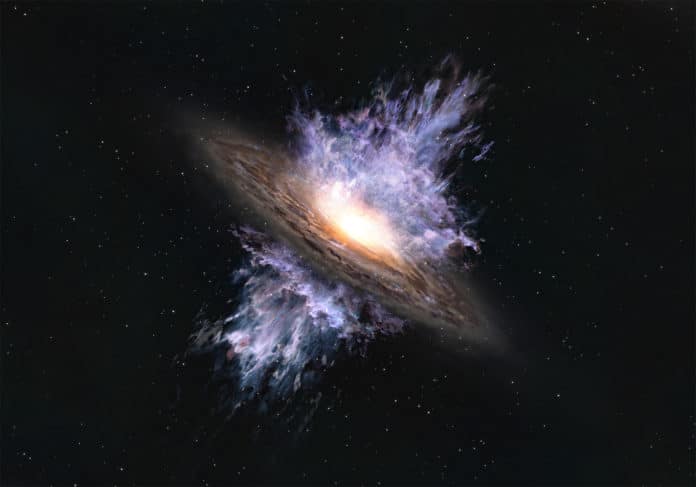There is a black hole at the center of every galaxy that is millions to billions of times more massive than the Sun.
The mass of the black hole is generally relative to the mass of the galaxy’s central region in the nearby universe. Isn’t it strange?
The reason is that the sizes of galaxies and black holes differ by about ten orders of magnitude. Because of this proportional relationship between the masses of two different-sized objects, astronomers assume that galaxies and black holes grew and evolved together (coevolution) through some physical interaction.
According to scientists, a galactic wind can provide physical interaction between black holes and galaxies. Galactic winds are considered an essential function in the evolution of a galaxy. The galactic wind is a high-velocity stellar wind emanating from either newly formed massive stars, spiral density waves, or as the result of the effects of supermassive black holes.
When did galactic winds come into existence in the universe?
Takuma Izumi, the lead author of the research paper and a researcher at the National Astronomical Observatory of Japan (NAOJ), said, “This is an important question because it is related to an important problem in astronomy: How did galaxies and supermassive black holes coevolve?”
Scientists used data from NAOJ’s Subaru Telescope to search for supermassive black holes to figure out the answer. The data revealed more than 100 galaxies with supermassive black holes in the universe more than 13 billion years ago.
Later, by using ALMA’s high sensitivity, scientists investigated the motion of gas in the host galaxies of the black holes.
ALMA observed a galaxy HSC J124353.93+010038.5 aka J1243+0100 and captured radio waves emitted by the dust and carbon ions in the galaxy.
Detailed investigation of the galaxy revealed a titanic galactic wind, moving at 500 km per second, driven by a supermassive black hole. The wind’s energy was extreme enough to push away the stellar material in the galaxy and stop the star formation activity.
This is the earliest example yet observed of such wind to date and is a telltale sign that huge black holes profoundly affect the growth of galaxies from the very early history of the universe.
Scientists also measured the motion of the quiet gas in J1243+0100 and estimated the mass of the galaxy’s bulge. It was found to be 30 billion times that of the Sun. On the other hand, the mass of the galaxy’s supermassive black hole was about 1% of that.
The mass ratio of the bulge to the supermassive black hole in this galaxy is almost identical to the mass ratio of black holes to galaxies in the modern universe. This implies that the coevolution of supermassive black holes and galaxies has been occurring less than a billion years after the universe’s birth.
Izumi said, “Our observations support recent high-precision computer simulations which have predicted that coevolutionary relationships were in place even at about 13 billion years ago. We are planning to observe a large number of such objects in the future. We hope to clarify whether or not the primordial coevolution seen in this object is an accurate picture of the general universe at that time.”
This is the earliest example yet observed of such wind to date and is a telltale sign that huge black holes profoundly affect the growth of galaxies from the very early history of the universe.
Journal Reference:
- Subaru High-z Exploration of Low-Luminosity Quasars (SHELLQs). XIII. Large-scale Feedback and Star Formation in a Low-Luminosity Quasar at z = 7.07 on the Local Black Hole to Host Mass Relation. arxiv.org/abs/2104.05738
